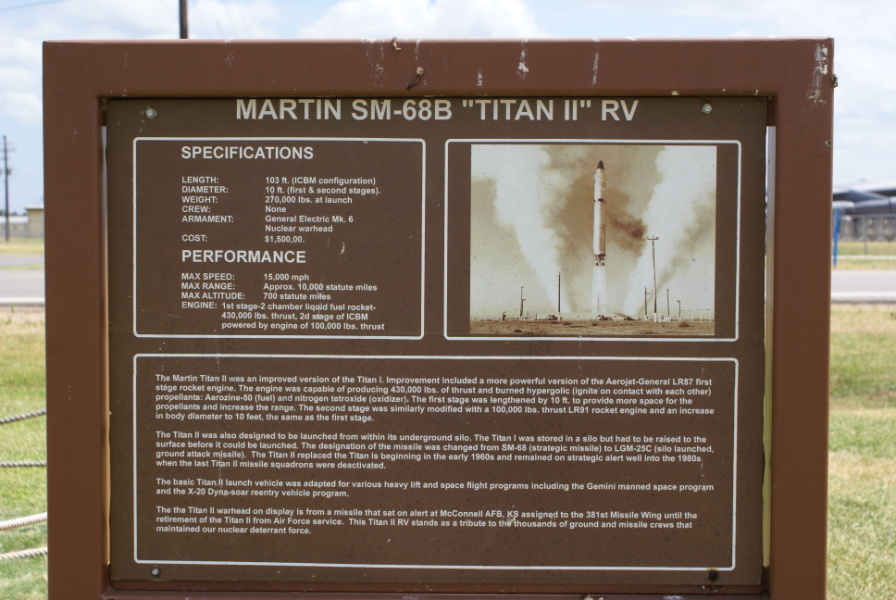| Prev |
heroicrelics.org Barksdale Global Power Museum (Formerly the 8th Air Force Museum) Site Index Titan II Mark 6 Reentry Vehicle Gallery |
Next |
dsc50619.jpg
The sign accompanying the reentry vehicle. It reads
Martin SM-68B "Titan II" RV
Specifications Length: 103 ft. (ICBM configuration) Diameter: 10 ft (first & second stages) Weight: 270,000 lbs. at launch Crew: None Armament: General Electric Mk. 6 Nuclear Warhead Cost: $1,500,000 Performance Max Speed: 15,000 mph Max Range: Approx. 10,000 statute miles Max Altitude: 700 statute miles Engine: 1st stage: 2 chamber liquid fuel rocket - 430,000 lbs. thrust 2d stage of ICBM powered by engine of 100,000 lbs. thrust The Martin Titan II was an improved version of the Titan I. Improvements included a more power version of the Aerojet-General LR87 first stage rocket engine. The engine was capable of producing 430,000 lbs. of thrust and burned hypergolic (ignite on contact with each other) propellants: Aerozine-50 (fuel) and nitrogen tetroxide (oxidizer). The first stage was lengthened by 10 ft. to provide more space for the propellants and increase the range. The second stage was similarly modified with a 100,000 lbs thrust LR91 rocket engine and an increase in body diameter to 10 feet, the same as the first stage.
The Titan II was also designed to be launched from within its underground silo. The Titan I was stored in a silo but had to be raised to the surface before it could be launched. The designation of the missile was changed from SM-68 (strategic missile) to LGM-25C (silo launched, ground attack missile). The Titan II replaced the Titan Is beginning in the early 1960s and remained on strategic alert well into the 1980s when the last Titan II missile squadrons were deactivated.
The basic Titan II launch vehicle was adapted for various heavy lift and space flight programs including the Gemini manned space program and the X-20 Dyna-soar reentry vehicle program.
The Titan II warhead on display is from a missile that sat on alert at McConnell AFB, KS assigned to the 381st Missile Wing until the retirement of the Titan II from Air Force Service. This Titan II RV stands as a tribute to the thousands of ground and missile crews that maintained our nuclear deterrent force.

| Time picture taken | Tue Aug 5 10:50:28 2008 |
| Location picture taken | Museum Grounds Southwest of Lindeberg Rd. Barksdale Global Power Museum (formerly the 8th Air Force Museum) Barksdale AFB, Louisiana |
| Prev | Titan II Mark 6 Reentry Vehicle Gallery | Next |